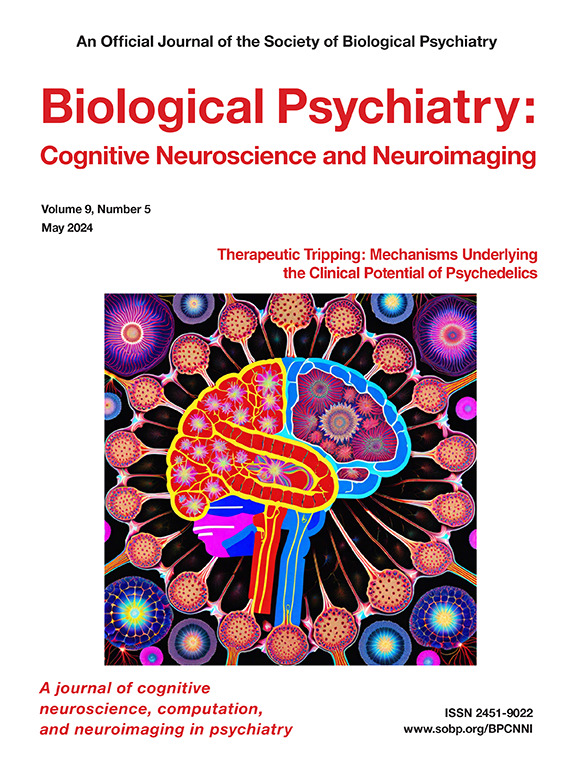酒精使用障碍患者在威胁预知过程中的有效连接性发生改变。
IF 5.7
2区 医学
Q1 NEUROSCIENCES
Biological Psychiatry-Cognitive Neuroscience and Neuroimaging
Pub Date : 2025-02-01
DOI:10.1016/j.bpsc.2024.07.023
引用次数: 0
摘要
背景:一种正在形成的理论和最新研究表明,对不确定的压力源或威胁的反应性增高可能是一个重要的个体差异因素,它促进过度饮酒,作为一种基于回避的应对手段,并成为当前和过去的酒精使用障碍(AUD)患者的特征。对不可预测威胁处理的神经影像学研究反复证明了前脑岛(AIC)、丘脑前内侧(AM)和背侧前扣带回皮层(dACC)的激活。本研究旨在了解这三个区域在预测不可预测的威胁(和可预测的威胁)时是如何作为一个网络发挥作用的:参与者包括 43 名患有 AUD 的年轻人(21-30 岁)和 26 名健康对照者。采用功能磁共振成像和动态因果模型研究区域间有效连接性以及该网络中与可预测和不可预测威胁相关的调节。参数经验贝叶斯模型用于进行有效连接性的组间比较:结果:在不可预测的威胁试验中,从右侧AM丘脑到右侧AIC的投射增加仅在AUD组显著存在。这种定向影响在平均每周饮酒较多的个体中更为明显。正如预期的那样,我们发现在可预测的威胁试验中,有效连接性的调节性变化没有组间差异:据我们所知,这是第一项研究对不可预测和可预测威胁的预期过程中关键前边缘区域之间的定向相互作用进行研究,并证明了丘脑-脑岛投射在AUD的不可预测威胁处理过程中的重要性。我们有必要进行前瞻性研究,以确定这种关联是否可能是因果关系。本文章由计算机程序翻译,如有差异,请以英文原文为准。
Altered Effective Connectivity During Threat Anticipation in Individuals With Alcohol Use Disorder
Background
A developing theory and recent research suggest that heightened reactivity to uncertain stressors or threats may be an important individual difference factor that facilitates excessive drinking as a means of avoidance-based coping and characterizes individuals with current and past alcohol use disorder (AUD). Neuroimaging studies of unpredictable threat processing have repeatedly demonstrated activation of the anterior insula, anteromedial thalamus, and dorsal anterior cingulate cortex. In the current study, we aimed to understand how these 3 regions function as a network during anticipation of unpredictable threat (and predictable threat).
Methods
Participants were 43 adults (ages 21–30) with AUD and 26 healthy control participants. Functional magnetic resonance imaging and dynamic causal modeling were used to study interregional effective connectivities and predictable and unpredictable threat-related modulations thereof within this network. Parametric empirical Bayesian modeling was used to conduct between-group comparisons in effective connectivities.
Results
During unpredictable threat trials, the increased projection from the right anteromedial thalamus to the right anterior insula was significantly present only in the AUD group. This directional influence was stronger among individuals who consumed more drinks per week on average. As expected, we found no group differences in modulatory changes to effective connectivities during predictable threat trials.
Conclusions
To our knowledge, this is the first study to examine directional interactions between key frontolimbic regions during anticipation of unpredictable and predictable threat and demonstrate the importance of bottom-up thalamic-insular projections during unpredictable threat processing in AUD. Prospective studies are warranted to determine whether this association is causal.
求助全文
通过发布文献求助,成功后即可免费获取论文全文。
去求助
来源期刊

Biological Psychiatry-Cognitive Neuroscience and Neuroimaging
Neuroscience-Biological Psychiatry
CiteScore
10.40
自引率
1.70%
发文量
247
审稿时长
30 days
期刊介绍:
Biological Psychiatry: Cognitive Neuroscience and Neuroimaging is an official journal of the Society for Biological Psychiatry, whose purpose is to promote excellence in scientific research and education in fields that investigate the nature, causes, mechanisms, and treatments of disorders of thought, emotion, or behavior. In accord with this mission, this peer-reviewed, rapid-publication, international journal focuses on studies using the tools and constructs of cognitive neuroscience, including the full range of non-invasive neuroimaging and human extra- and intracranial physiological recording methodologies. It publishes both basic and clinical studies, including those that incorporate genetic data, pharmacological challenges, and computational modeling approaches. The journal publishes novel results of original research which represent an important new lead or significant impact on the field. Reviews and commentaries that focus on topics of current research and interest are also encouraged.
 求助内容:
求助内容: 应助结果提醒方式:
应助结果提醒方式:


